[ad_1]
P.F. Chang’s is a casual family-centric restaurant chain that’s been around for over three decades. Although the restaurant is often thought of as being Chinese-focused, the inspiration for the menu stems from street food across all of Asia and features classic dishes ranging from dim sum to sushi to pad Thai.
Since the menu is so extensive, enjoying a main meal without derailing your healthy eating goals is possible. However, like most Asian-style dishes, sodium counts for most of the menu are sky-high, so even the best picks on P.F. Chang’s menu will likely exceed your daily sodium limit. For example, an order of Vegetarian Lettuce Wraps has just 260 calories but packs in 940 milligrams of sodium, which is more than 40% of the sodium you should have in an entire day.
To help you make better-for-you choices when dining out, we took a look at P.F. Chang’s menu to identify the healthiest and unhealthiest options available and compiled everything into one go-to guide.
One thing to note: P.F. Chang’s nutritional guide specifies how many servings each order contains and provides nutrition information per serving rather than per dish. For example, each pad Thai order comes with two servings, so the nutritional information is for half of the order—you’d double it if you ended up eating the entire meal. The best and worst menu items are based on the nutritional information provided per serving.
How to choose healthier foods at P.F. Chang’s:
- Order plant-based menu items like veggie lettuce wraps, edamame, vegetable spring rolls, lo mein vegetables, and tofu-based dishes.
- Look for chicken, seafood, and tofu for protein, not steak or pork. The main dishes made with chicken, salmon, shrimp, and tofu tend to be significantly lower in calories and saturated fat compared to dishes made with ingredients like spare ribs and Mongolian beef.
- Stick to the number of servings per dish. Many dishes on P.F. Chang’s menu are served anywhere from two to eight servings, so consider that the menu item you order is based on two portions. For example, the sushi is based on one piece or eight servings per menu item, whereas the dumplings serve six, and most entrees are supposed to be two servings.
- Avoid menu items that say “crispy,” notes Rhyan Geiger, RDN, owner of Phoenix Vegan Dietitian. When menu items say “crispy,” it means it’s likely battered and fried. The crispy green beans on the menu, for example, have 39 grams of fat in total, 6 of which are saturated. The American Heart Association suggests limiting saturated fat to no more than 5 to 6% of calories, which is around 13 grams for a 2,000-calorie diet.
- Look for steamed menu items. Steaming chicken, tofu, and seafood instead of frying them results in significantly lower calories, fat, and saturated fat dishes.
Here are 20 best and worst options according to registered dietitians
Appetizers
Best: Edamame
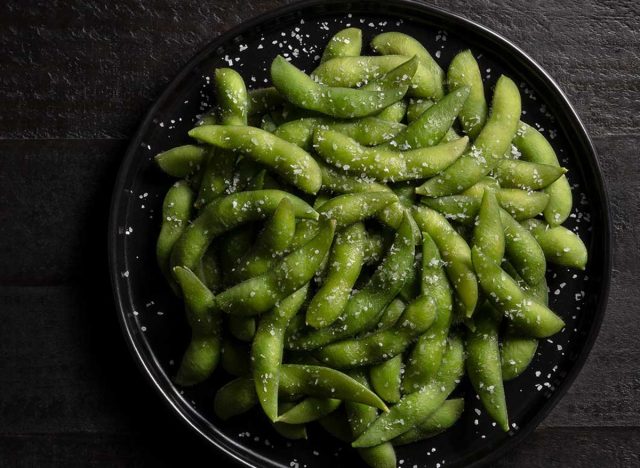

Nutrition (Per serving):
Calories: 200
Fat: 8 g (Saturated fat: 1.5 g)
Sodium: 980 mg
Carbs: 12 g (Fiber: 6 g, Sugar: 0 g)
Protein: 18 g
“This is the perfect start to a meal,” says Patricia Bannan, MS, RDN, nationally recognized registered dietitian nutritionist and author of From Burnout to Balance. “One serving provides 18 grams of plant-based protein and 6 grams of gut-friendly dietary fiber for 200 calories.” Plus, you’re getting the health benefits of soy-based plant compounds, which may reduce the risk of heart disease and some cancers, as well as improve bone health, adds Bannan.
Best: Chang’s Chicken Lettuce Wraps


Nutrition (Per serving):
Calories: 330
Fat: 13 g (Saturated fat: 3 g)
Sodium: 920 mg
Carbs: 33 g (Fiber: 4 g, Sugar: 14 g)
Protein: 19 g
Chang’s Chicken Lettuce Wraps are a top appetizer pick for their flavor appeal and nutritional benefits. “A serving provides a satisfying combination of 19 grams of protein and 4 grams of fiber per serving, they provide a balanced and filling start to your meal,” says Bannan. However, like many options on the menu, they are high in sodium, and they have 3.5 teaspoons of added sugar.
Worst: Crispy Green Beans
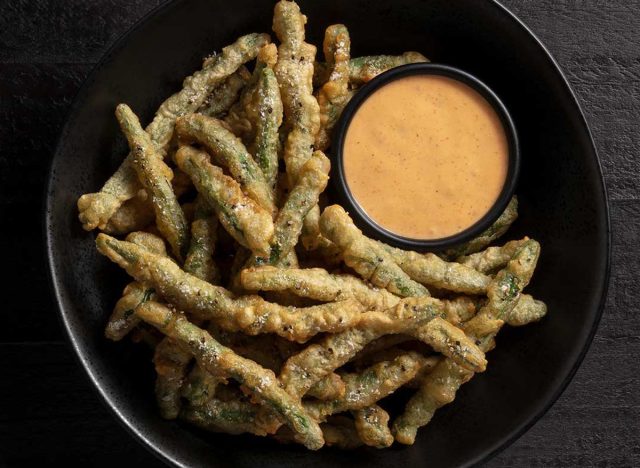

Nutrition (Per serving):
Calories: 500
Fat: 39 g (Saturated fat: 6 g)
Sodium: 750 mg
Carbs: 35 g (Fiber: 4 g, Sugar: 6 g)
Protein: 4 g
Don’t be fooled by the healthful sounding Crispy Green Beans, notes Bannan. “Despite their vegetable origins, their frying process makes them the highest-calorie option on P.F. Chang’s appetizer menu, packing a hefty 39 grams of fat, surpassing even the BBQ Pork Spare Ribs.”
Worst: BBQ Pork Spare Ribs


Nutrition (Per serving):
Calories: 430
Fat: 14 g (Saturated fat: 7 g)
Sodium: 450 mg
Carbs: 17 g (Fiber: 1 g, Sugar: 15 g)
Protein: 19 g
This appetizer’s serving is three spare ribs or half of the menu item. The main pitfalls with these spare ribs is the amount of saturated fat and added sugar. The spare ribs have nearly 4 teaspoons of sugar.
Dim Sum
Best: Vegetable Spring Rolls


Nutrition (Per serving):
Calories: 240
Fat: 12 g (Saturated fat: 2 g)
Sodium: 280 mg
Carbs: 30 g (Fiber: 1 g, Sugar: 8 g)
Protein: 3 g
While dim sum options generally tend to be higher in carbs and lower in protein and fiber compared to other starters on the menu, there are still some healthier choices available. Bannan recommends ordering the Vegetable Spring Rolls for a lower-calorie and -sodium choice compared to other Dim Sum options.
Best: Handmade Pork Dumplings Pan Fried


Nutrition (Per Dumplin g):
Calories: 90
Fat: 5 g (Saturated fat: 1.5 g)
Sodium: 230 mg
Carbs: 7 g (Fiber: 0 g, Sugar: 2 g)
Protein: 3 g
These pork dumplings are 90 calories each and they are lower in calories and saturated fat than many other Dim Sum options. For example, the Pork Egg Rolls pack in more than three times the calories (350 calories each), advises Bannan.
Worst: Pork Egg Rolls


Nutrition (Per Dumplin g):
Calories: 350
Fat: 19 g (Saturated fat: 3.5 g)
Sodium: 460 mg
Carbs: 34 g (Fiber: 3 g, Sugar: 7 g)
Protein: 9 g
These pork egg rolls are the worst choice of the dim sum options. One roll has 350 calories and 19 grams of fat. For a starter, these egg rolls will derail your best efforts to level up your eating.
Main Course
Best: Shrimp with Lobster Sauce Steamed
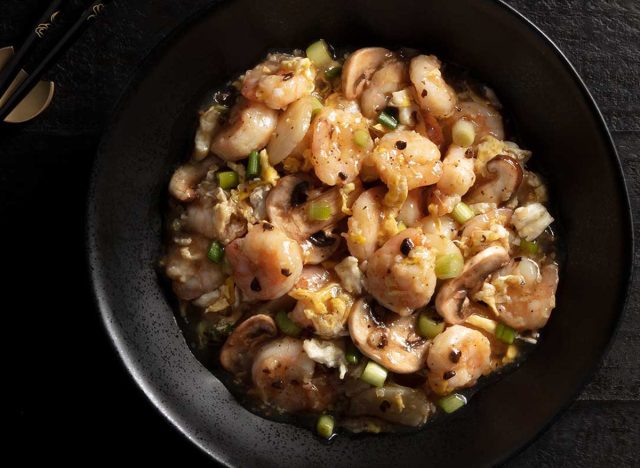

Nutrition (Per serving):
Calories: 190
Fat: 10 g (Saturated fat: 1.5 g)
Sodium: 1,390 mg
Carbs: 7 g (Fiber: 1 g, Sugar: 2 g)
Protein: 16 g
This main dish has modest calories, fat, and saturated fat, and it is relatively low in carbohydrates. As a bonus, it provides 16 grams of high-quality protein. The downside of this choice is its sodium content, which is excessive like most of the menu items from the chain.
Best: Pepper Steak Steamed
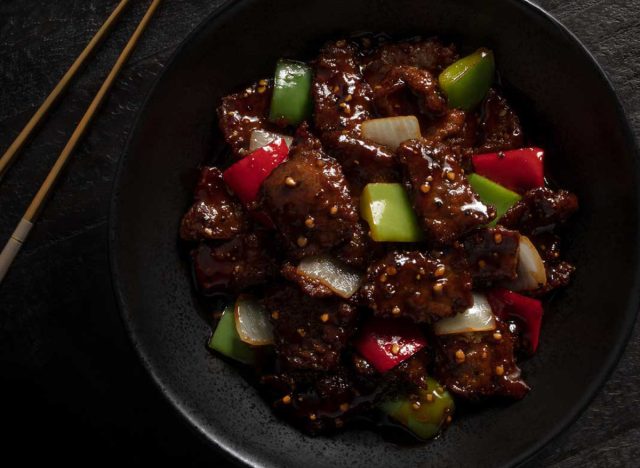

Nutrition (Per serving):
Calories: 300
Fat: 15 g (Saturated fat: 4.5 g)
Sodium: 950 mg
Carbs: 14 g (Fiber: 2 g, Sugar: 8 g)
Protein: 19 g
The steamed menu options at P.F. Chang’s are significantly lower in fat, saturated fat, and calories compared to their stir-fried or deep-fried counterparts. This pepper steak keeps carbs, added sugar, and calories in check while packing in 19 grams of high-quality protein.
Best: Miso Glazed Salmon


Nutrition (Per serving):
Calories: 320
Fat: 18 g (Saturated fat: 3 g)
Sodium: 670 mg
Carbs: 14 g (Fiber: 2 g, Sugar: 9 g)
Protein: 25 g
The menu states this entrée serves two. It makes our best bet choice because it is one of the lowest options in terms of saturated fat and sodium for all the entrees on the menu. Salmon is also rich in omega-3 fatty acids, a type of fat that lowers inflammation and helps protect your heart, brain, and eyes.
Worst: Fire Braised Short Ribs


Nutrition (Per serving):
Calories: 770
Fat: 50 g (Saturated fat: 23 g)
Sodium: 1,150 mg
Carbs: 51 g (Fiber: 1 g, Sugar: 17 g)
Protein: 26 g
The short ribs are among the highest in fat and saturated fat on the entire menu. It has about two days’ worth of saturated fat. This menu items also has more than four teaspoons of added sugars and the sodium counts are stratospheric.
Worst: Sesame Chicken


Nutrition (Per serving):
Calories: 490
Fat: 24 g (Saturated fat: 4.5 g)
Sodium: 1,030 mg
Carbs: 30 g (Fiber: 2 g, Sugar: 24 g)
Protein: 24 g
You’d think that this popular and seemingly simple dish would be nutritious, but not so fast. Any entree that has the same amount of protein as added sugar should be avoided. This Sesame Chicken has 6 teaspoons of added sugar, thanks to the sugary sauce.
Worst: Orange Chicken


Nutrition (Per Servin g):
Calories: 580
Fat: 29 g (Saturated fat: 4.5 g)
Sodium: 910 mg
Carbs: 44 g (Fiber: 2 g, Sugar: 28 g)
Protein: 33 g
Thanks to being battered and fried and smothered in a sugary, citrus sauce, this entry makes the worst options of all of the main dishes. It has just too much of everything: calories, fat, saturated fat, sodium, carbs, and protein. The biggest offender is the 7 teaspoons of sugar in a savory entree. That’s more like a dessert than a chicken entree.
Soups & Salads
Best: Egg Drop Soup Cup
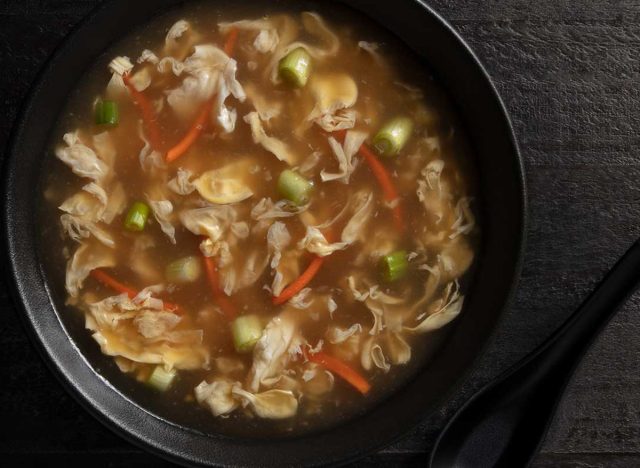

Nutrition (Per cup):
Calories: 40
Fat: 1 g (Saturated fat: 0 g)
Sodium: 560 mg
Carbs: 6 g (Fiber: 0 g, Sugar: 2 g)
Protein: 1 g
This Chinese staple is made from a chicken broth base with beaten eggs. Ordering a cup keeps this portion in check, which makes calories, fat, saturated fat, and carbs low.
Best: Asian Caesar Salad
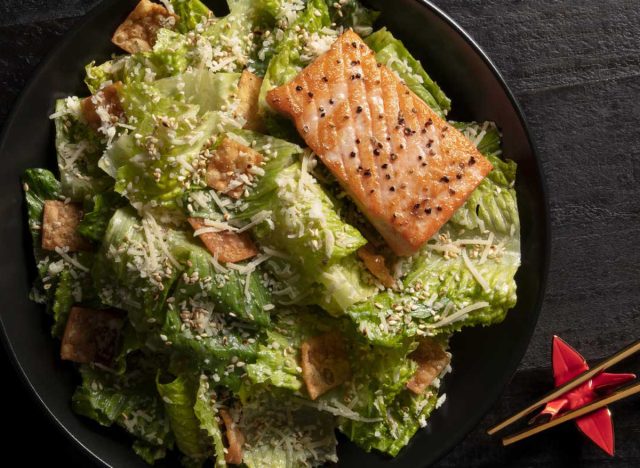

Nutrition (Per serving):
Calories: 210
Fat: 15 g (Saturated fat: 3.5 g)
Sodium: 440 mg
Carbs: 11 g (Fiber: 2 g, Sugar: 1 g)
Protein: 8 g
This salad is made with romaine, parmesan, toasted sesame seeds, and wonton croutons with a classic Caesar dressing. Without added protein, like chicken or salmon, this is a lower-calorie starter for a main course. You can always add chicken or salmon and turn it into a hearty meal. Adding chicken or salmon will add 140 or 160 calories to the salad respectively.
Worst: Mandarin Crunch Salad


Nutrition (Per serving):
Calories: 370
Fat: 23 g (Saturated fat: 3 g)
Sodium: 750mg
Carbs: 38 g (Fiber: 4 g, Sugar: 21 g)
Protein: 7 g
This salad combines a variety of healthful veggies, including cabbage, but the issue with this salad is that it has 21 grams or just over 5 teaspoons of sugar per serving, mostly coming from the mandarin vinaigrette. Like many dishes on the menu, sugar counts are high due to the sauces.
Noodles & Rice
Best: Lo Mein Vegetables


Nutrition (Per serving):
Calories: 360
Fat: 7 g (Saturated fat: 1 g)
Sodium: 1,550 mg
Carbs: 63 g (Fiber: 5 g, Sugar: 14 g)
Protein: 11 g
This classic dish is made with lo mein noodles, broccoli, snap peas, garlic, cabbage, celery, carrot, onion, togarashi bean sprouts, shiitake mushrooms, sesame oil, and a vegetarian dark sauce. This is one of the most veggie-packed dishes on the P.F. Chang’s menu. From all the veggies, the dish has 5 grams of fiber and only 1 gram of saturated fat.
Best: Fried Rice & Chicken


Nutrition (Per serving):
Calories: 420
Fat: 10 g (Saturated fat: 2 g)
Sodium: 880 mg
Carbs: 76 g (Fiber: 2 g, Sugar: 9 g)
Protein: 25 g
This fan favorite is made with rice that is wok-tossed with egg, carrots, bean sprouts, green onion, and chicken. It is one of the noodle and rice options that is less than most. What’s more, the added sugars in this dish are half of what’s in several of the other options in this section of the menu.
Worst: Korean Glass Noodles Combo
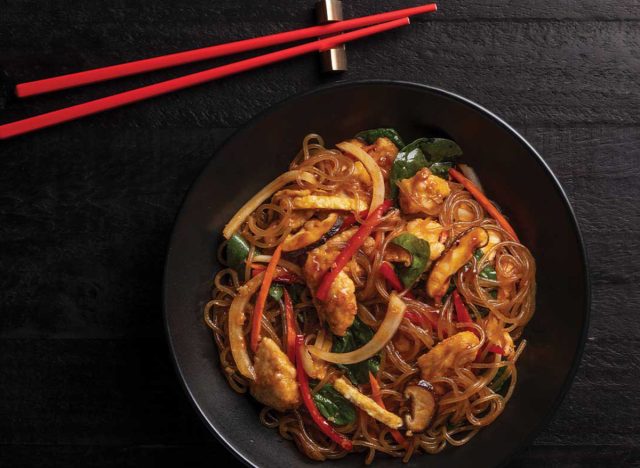

Nutrition (Per serving):
Calories: 500
Fat: 19 g (Saturated fat: 4 g)
Sodium: 1,290 mg
Carbs: 60 g (Fiber: 3 g, Sugar: 19 g)
Protein: 24 g
This classic Korean dish is made with sweet potato glass noodles, onion, mushrooms, bell pepper, egg, and sweet-spicy sauce. The problem with this dish is that it will weigh you down with carbs, calories, fat, sodium, and 5 teaspoons of sugar.
Worst: Chicken Pad Thai


Nutrition (Per serving):
Calories: 670
Fat: 18 g (Saturated fat: 3 g)
Sodium: 1,450 mg
Carbs: 95 g (Fiber: 4 g, Sugar: 26 g)
Protein: 34 g
This classic Thai dish is one of the worst items to order based on its calories, sodium, carbs, and sugar content. If you stick to eating half of the order (each order contains two servings), you’ll consume 670 calories and a whopping 1,450 milligrams of sodium, which is more than half of what you should have in a day. On top of all that, you’ll get nearly 400 calories of pure carbs from the noodles and 6.5 teaspoons of added sugars in this dish.
Click here to get Special Complimentary Coaching at discounted price while it’s still available…
[ad_2]



